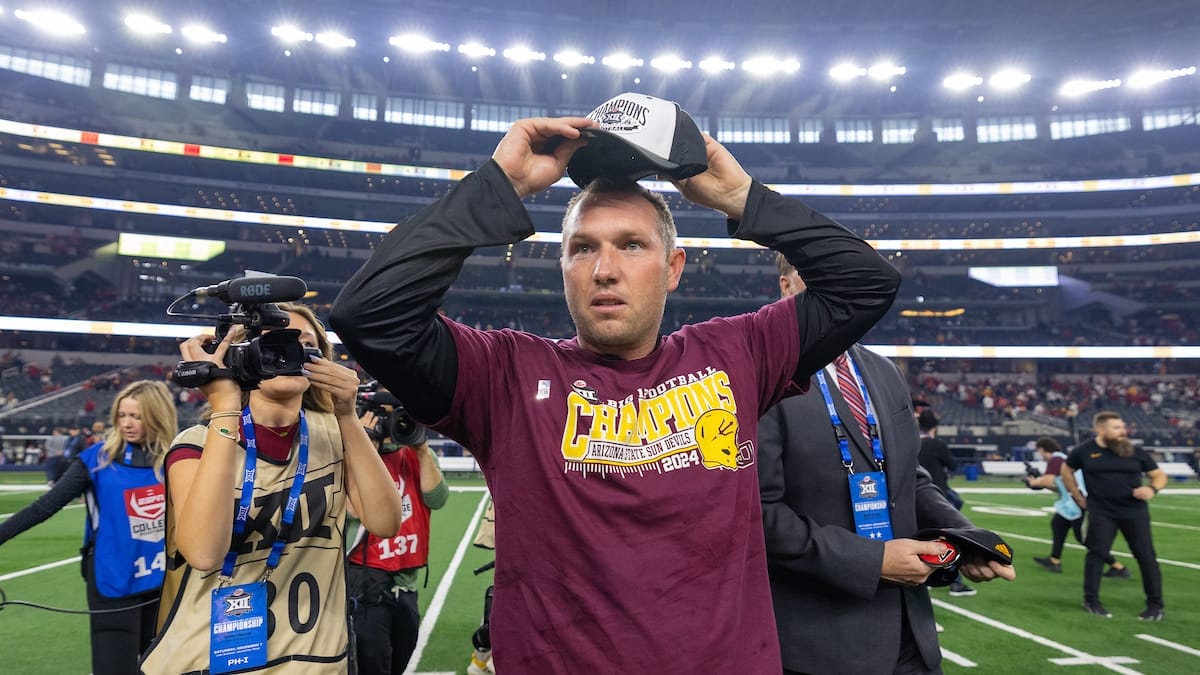The state of college sports could calmly be described as the Wild, Wild West, a stage for an old-fashioned duel between programs and the NCAA, with athletes standing somewhere in the middle.
Texas is a fitting setting for such showdowns.
LOCAL NEWS: Arizona Cardinals will host first Mental Health Awareness Game in December
INDUSTRY INSIGHTS: Want more news like this? Get our free newsletter here
Big 12 Media Days provided several opportunities for coaches in the conference to voice their displeasure with the current system and how players are paid like NFL stars. Even though power conference teams like those within the Big 12 do benefit in terms of securing more commitments from the best available players, they realize it’s an unjust and unfair system that could monopolize the sport indefinitely.
“We’re in the profession and we don’t even know the rules,” Cincinnati football coach Scott Satterfield said. “It’s difficult, and it’s ever-changing. There’s nothing that’s been stable, really, since 2020. Things have changed so much and so fast.”
Recruiting is among the biggest challenges. Though the NCAA reached a settlement in June that would give $2.8 billion for colleges to pay athletes, the NCAA is negotiating with House plaintiff lawyers to apply rules and repercussions to schools that attempt to avoid the cap in compensation packages offered to incoming players. Third-party NIL deals are being fully guaranteed, which would go against new revenue-sharing rules. Programs are also offering contracts that would be impossible to fit beneath the $20.8 million annual compensation cap.
Arizona State coach Kenny Dillingham, who captured the Big 12 crown last season behind a slew of portal additions, is eager for a clear-cut direction for the sport so college football can return to what he believes are the values at its core.
“I just want to know the rules,” Dillingham said. “Tell us where the sandbox is and we’ll play in it. At the end of the day, this is a game. I know this is a business, I know this is a profession for everybody. But anybody who’s not in this to see a kid go from an 18-year-old kid to a 22-year-old man, and enter the real world, is in it for the wrong reasons.”
In a time when players can earn millions of dollars as freshmen or by entering the portal, the players a team retains for several years become the most crucial ones on the roster.
“In this new era where you have 105 kids on scholarship, it’s all about retaining the guys on your team,” Dillingham said. “If you constantly are looking for the next best thing to replace the guys on your team, then your own guys and your team should leave. Why wouldn’t they? If you’re not loyal to them, they shouldn’t be loyal to you.”
The two-way street of loyalty and trust between players and coaching staff is occasionally the deciding factor for players being recruited with similarly hefty bags of cash. Coaches argue that it should return to the forefront of the recruiting process. That point is only emphasized by the fact that hundreds of submitted NIL deals hang in limbo while the College Sports Commission and NIL clearinghouse manage the fallout of the settlement.
Colorado coach Deion Sanders proposed a hard salary cap with a system to tier rank player salaries based on ability and overall performance.
“I wish there was a cap,” Sanders said. “The top-of-the-line guy player makes this, and if you’re not that type of guy, you know you’re not going to make that. That’s what the NFL does. The problem is you have a guy that’s not that darn good, but he could go to another school and they give him half a million dollars, and you can’t compete with that. It doesn’t make sense.”
Moments earlier, however, Sanders praised Texas Tech coach Joey McGuire for spending aggressively in the transfer portal. The Red Raiders flipped their team into a recruiting juggernaut almost overnight, spending upwards of $50 million on players, which was split into $30 million front-loaded and another $20.5 million courtesy of the revenue-share. Front-loaded contracts allowed school collectives to pay players before the enforcement of the settlement on July 1.
McGuire, whose Red Raiders figure to contend for the Big 12 title and a College Football Playoff selection this fall, said his aggression is just taking advantage of the current state of affairs, and more schools should do the same to compete with the annual contenders from the SEC and Big Ten.
Utah coach Kyle Whittingham, entering his 21st season at the helm of the Utes, echoed Sanders’ sentiment about a salary cap. He acknowledged that players are moving toward becoming official employees, though the contracts they are now signing to get paid make them employees in every way but the official title. Whittingham remains unsure of the extent to which he supports employing college athletes.
“You say, ‘college football’s not the NFL,’ but the NFL has been doing some good things for a lot of years,” Whittingham said. “We ought to take some pages from them on how to implement a salary cap and collective bargaining if it comes to that. … As distasteful as it might sound to some people, I think an NFL minor league model is the best direction to hit.”
Until new policies can be enforced at every level of college football to ensure more parity and a fair state of play, the formula for winning national championships is printed on a blank check.
“All you have to do is look at the College Football Playoff and see what those teams spent,” Sanders said. “And you’ll understand darn well why they’re in the playoffs.”




